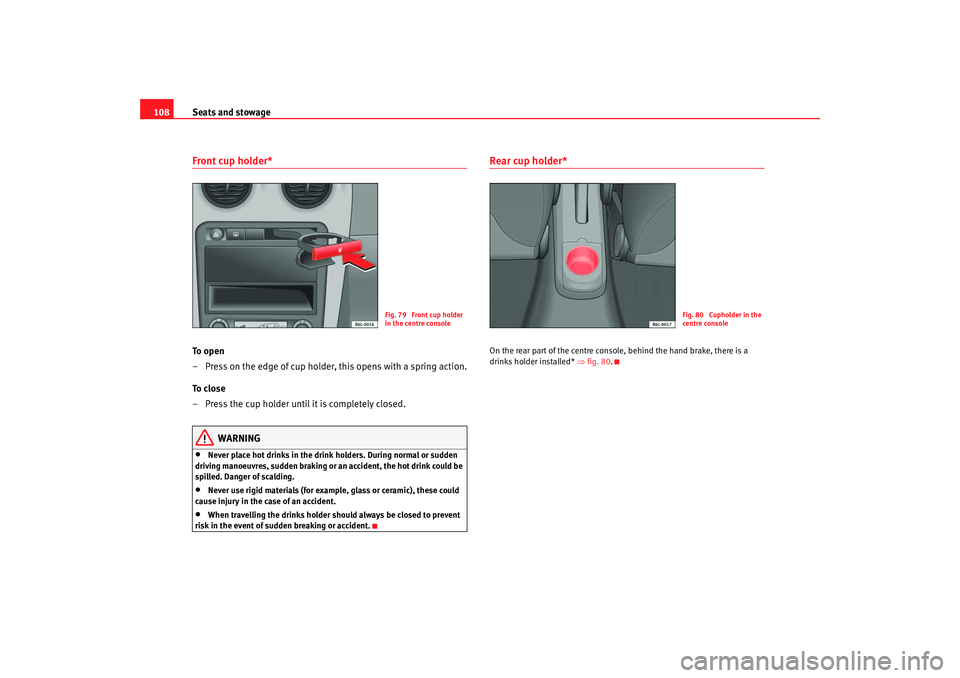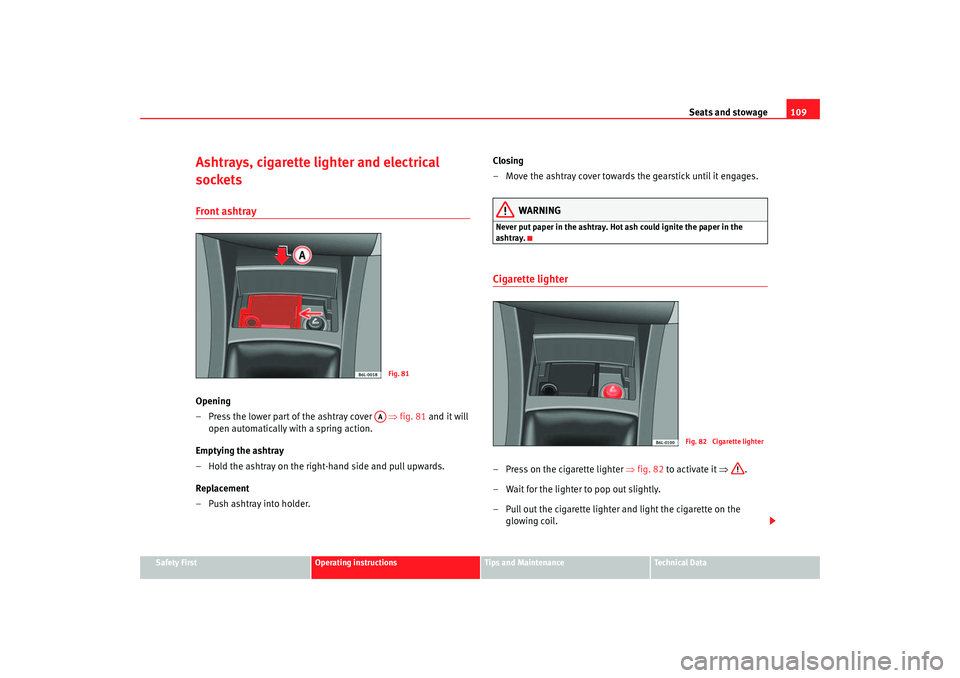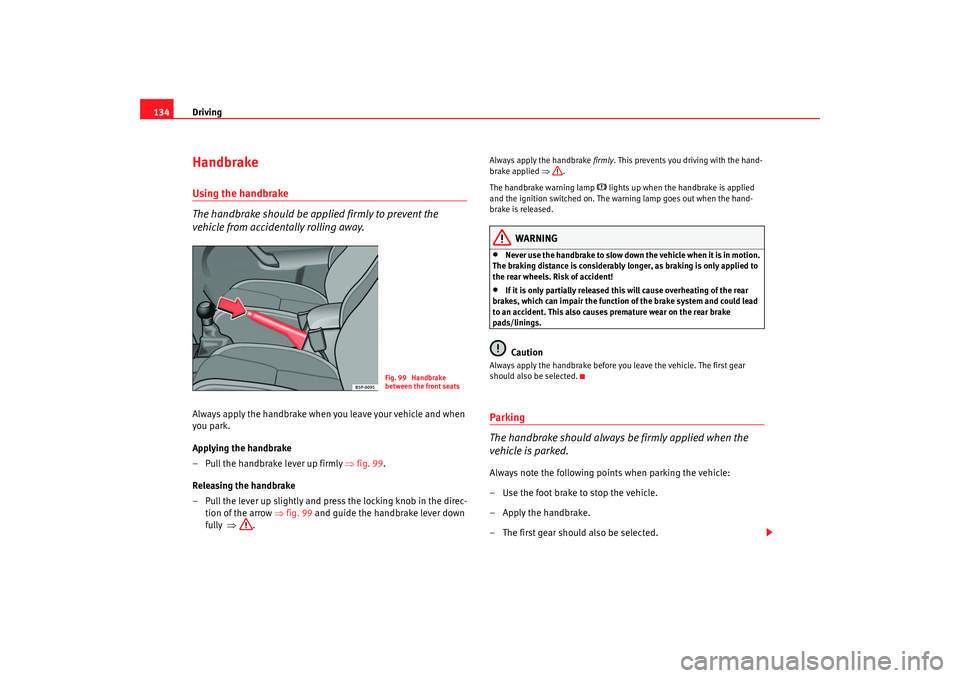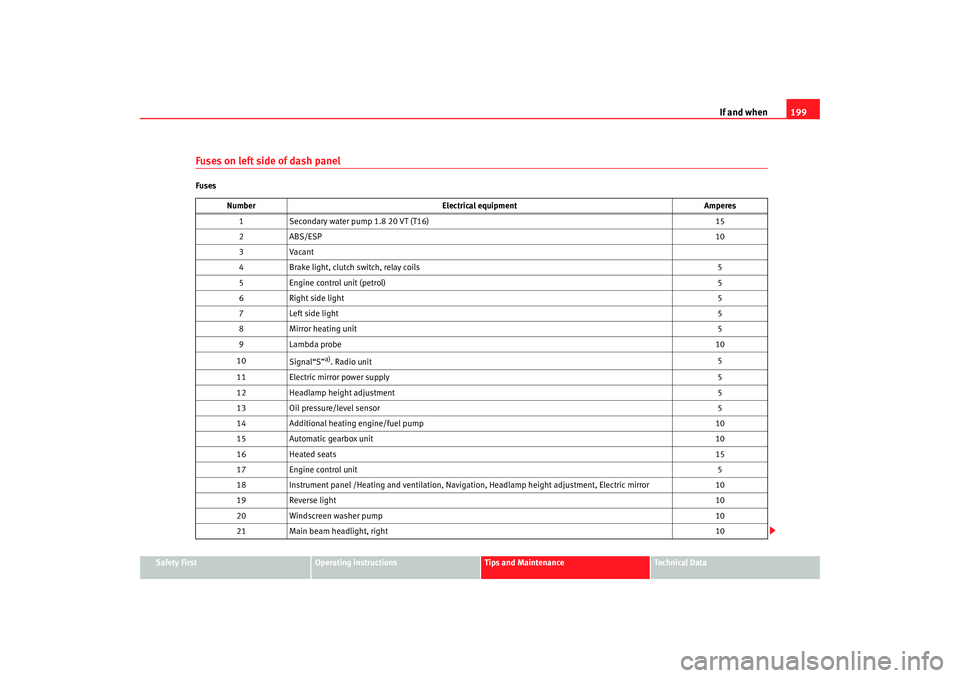2005 Seat Ibiza 5D seats
[x] Cancel search: seatsPage 110 of 252

Seats and stowage
108Front cup holder* To o p e n
– Press on the edge of cup holder, this opens with a spring action.
To close
– Press the cup holder until it is completely closed.
WARNING
•
Never place hot drinks in the drink holders. During normal or sudden
driving manoeuvres, sudden braking or an accident, the hot drink could be
spilled. Danger of scalding.
•
Never use rigid materials (for example, glass or ceramic), these could
cause injury in the case of an accident.
•
When travelling the drinks holder should always be closed to prevent
risk in the event of sudden breaking or accident.
Rear cup holder* On the rear part of the centre console, behind the hand brake, there is a
drinks holder installed* ⇒ fig. 80.
Fig. 79 Front cup holder
in the centre console
Fig. 80 Cupholder in the
centre console
ibiza_ingles Seite 108 Mittwoch, 5. Oktober 2005 5:17 17
Page 111 of 252

Seats and stowage109
Safety First
Operating instructions
Tips and Maintenance
Te c h n i c a l D a t a
Ashtrays, cigarette lighter and electrical
socketsFront ashtrayOpening
–Press the lower part of the a shtray cover ⇒
fig.
81 and it will
open automatically with a spring action.
Emptying the ashtray
– Hold the ashtray on the right-hand side and pull upwards.
Replacement
– Push ashtray into holder. Closing
– Move the ashtray cover towards the gearstick until it engages.
WARNING
Never put paper in the ashtray. Hot ash could ignite the paper in the
ashtray.Cigarette lighter– Press on the cigarette lighter
⇒fig. 82 to activate it ⇒.
– Wait for the lighter to pop out slightly.
– Pull out the cigarette lighter and light the cigarette on the glowing coil.
Fig. 81
AA
Fig. 82 Cigarette lighter
ibiza_ingles Seite 109 Mittwoch, 5. Oktober 2005 5:17 17
Page 112 of 252

Seats and stowage
110
WARNING
•
Improper use of the cigarette lighter can lead to serious injuries or start
a fire.
•
Take care when using the cigarette lighter. Carelessness or negligence
when using the cigarette lighter can cause burns, risk of injury.
•
The cigarette lighter also works when the ignition is off and when the
ignition key is removed. To avoid the risk of fire, never leave children unsu-
pervised in the vehicle.
Electrical sockets The 12 Volt cigarette lighter socket can also be used for other electrical
components with a power rating of up to 120 Watt. When the engine is
switched off, however, the vehicle battery will discharge. Further information
⇒ page 162
WARNING
The electrical sockets and any appli ances connected to them are also func-
tional with the ignition switched off and the key removed. Improper use of
the sockets or electrical accessories can lead to serious injuries or cause a
fire. To avoid the risk of injury, never leave children unsupervised in the
vehicle.
Note
•
Using electrical appliances with the engine switched off will drain the
battery.
•
Before using any electrical accessories, see the instructions on
⇒ page 162.
First-aid kit, warning triangle, fire
extinguisherFirst aid kit, warning triangle and fire extinguisherThe use of reflective warning triangles is obligatory in emergencies in some
countries. As are the first aid kit and a set of spare lightbulbs.
The first aid kit and extinguisher may be placed in the boot, in the lateral allot-
ments and held in place by the Velcro.
The warning triangle may be placed on the rear wall of the luggage compart-
ment, held in place by the rubber bands.
Note
•
The first aid kit, the warning triangles and the fire extinguisher are not
supplied with the vehicle as standard.
•
The first aid kit, the warning triangles and the fire extinguisher should
meet legal requirements.
•
The expiry date of the content of the first aid kit should be checked.
•
Ensure that the fire extinguisher is fully functional. The fire extinguisher
should, therefore, be checked regularly. The sticker on the fire extinguisher
will inform you of the next date for checking.
•
Before acquiring accessories and em ergency equipment see the instruc-
tions on ⇒page 162, “Accessories, parts replacement and modifications”.
ibiza_ingles Seite 110 Mittwoch, 5. Oktober 2005 5:17 17
Page 113 of 252

Seats and stowage111
Safety First
Operating instructions
Tips and Maintenance
Te c h n i c a l D a t a
Luggage compartmentStowing luggage
All luggage must be securely stowed.Please observe the following points to ensure the vehicle handles
well at all times:
– Distribute the load as evenly as possible.
– Place heavy objects as far forward in the luggage compartment
as possible.
– Secure luggage in the luggage compartment with suitable straps on the fastening rings.
WARNING
•
Loose luggage and other loose items in the vehicle can cause serious
injuries.
•
Loose objects in the luggage compartment can suddenly move and
change the way the vehicle handles.
•
During sudden manoeuvres or accidents, loose objects in the
passenger compartment can be flung forward, injuring vehicle occupants.
•
Always store objects in the luggage compartment and secure with suit-
able straps. This is especially important for heavy objects.
•
When you transport heavy objects, always keep in mind that a change
in the centre of gravity can also cause changes in vehicle handling.
•
Please observe information on safe driving ⇒page 7, “Safe driving”.
Caution
Hard objects on the shelf could chafe against the wires of the heating
element in the rear window and cause damage.
Note
The ventilation slots in front of the r ear side windows must not be covered as
this would prevent stale air being extracted from the vehicle.Fastening rings*Four rings are fitted in the boot ⇒fig. 83 (see arrows) for securing objects.
Two of the rings are located on the right and left, respectively, of the rear
section of the boot. The other two are next to the loading edge of the boot.
The fastening rings are in accordance with standard DIN 75410
Fig. 83 Fastening rings
ibiza_ingles Seite 111 Mittwoch, 5. Oktober 2005 5:17 17
Page 114 of 252

Seats and stowage
112Luggage compartment coverRemoving the cover
– Disengage the loops ⇒ fig. 84 from the allotments .
– Extract the cover from its allotment, in its rest position and pull outwards.
WARNING
Do not place heavy or hard objects on the luggage compartment cover, this
will endanger the vehicle occupants in case of sudden braking.
Note
•
Ensure that, when placing items of clothing on the luggage compartment
cover, that rear visibility is not reduced.
Roof carrier*Please observe the following points if you intend to carry loads on the roof:•
For safety reasons, only luggage racks and accessories supplied by offi-
cial SEAT Service should be used.
•
It is imperative to precisely follow the fitting instructions included for the
rack, taking special care when fitting th e front bar in the allotments designed
for this and the rear bar between the marks on the upper part of the rear door
frame while respecting the correct direction of travel indicated in the installa-
tion manual. Not following these instr uctions may lead to paintwork damage
or marks on the bodywork.
•
Pay special attention to the tightening torque of the attachment bolts and
check them following a short journey. If necessary, retighten the bolts and
check them at regular intervals.
•
Distribute the load evenly. A maximum load of 40 kg only is permitted for
each roof carrier system support bar, the load must be distributed evenly over
the entire length. However, the maxi mum load permitted for the entire roof
(including the support system) of 75 kg must not be exceeded nor should the
total weight of the vehicle be exceeded. See the chapter on “Technical Data”.
•
When transporting heavy or large objects on the roof, any change in the
normal vehicle behaviour due to a change in the centre of gravity or an
increased wind resistance must be taken into account. For this reason, a suit-
able speed and driving style must be used.
•
For those vehicles fitted with a sunroof*, ensure that it does not contact
the load on the roof carrier system when opened.
Fig. 84 Luggage
compartment cover
AB
AA
ibiza_ingles Seite 112 Mittwoch, 5. Oktober 2005 5:17 17
Page 136 of 252

Driving
134HandbrakeUsing the handbrake
The handbrake should be applied firmly to prevent the
vehicle from accidentally rolling away.Always apply the handbrake when you leave your vehicle and when
you park.
Applying the handbrake
– Pull the handbrake lever up firmly ⇒fig. 99 .
Releasing the handbrake
– Pull the lever up slightly and press the locking knob in the direc- tion of the arrow ⇒fig. 99 and guide the handbrake lever down
fully ⇒ .
Always apply the handbrake firmly. This prevents you driving with the hand-
brake applied ⇒.
The handbrake warning lamp
lights up when the handbrake is applied
and the ignition switched on. The warning lamp goes out when the hand-
brake is released.
WARNING
•
Never use the handbrake to slow down the vehicle when it is in motion.
The braking distance is considerably longer, as braking is only applied to
the rear wheels. Risk of accident!
•
If it is only partially released this will cause overheating of the rear
brakes, which can impair the function of the brake system and could lead
to an accident. This also causes premature wear on the rear brake
pads/linings.Caution
Always apply the handbrake before you leave the vehicle. The first gear
should also be selected.Parking
The handbrake should always be firmly applied when the
vehicle is parked.Always note the following points when parking the vehicle:
– Use the foot brake to stop the vehicle.
–Apply the handbrake.
– The first gear should also be selected.
Fig. 99 Handbrake
between the front seats
ibiza_ingles Seite 134 Mittwoch, 5. Oktober 2005 5:17 17
Page 201 of 252

If and when199
Safety First
Operating instructions
Tips and Maintenance
Te c h n i c a l D a t a
Fuses on left side of dash panelFuses
Number Electrical equipment Amperes
1 Secondary water pump 1.8 20 VT (T16) 15
2A BS/E S P 10
3 Vacant
4 Brake light, clutch switch, relay coils 5
5 Engine control unit (petrol) 5
6 Right side light 5
7 Left side light 5
8 Mirror heating unit 5
9 Lambda probe 10
10 Signal“S”
a). Radio unit 5
11 Electric mirror power supply 5
12 Headlamp height adjustment 5
13 Oil pressure/level sensor 5
14 Additional heating engine/fuel pump 10
15 Automatic gearbox unit 10
16 Heated seats 15
17 Engine control unit 5
18 Instrument panel /Heating and ventilation, Navigation, Headlamp height adjustment, Electric mirror 10
19 Reverse light 10
20 Windscreen washer pump 10
21 Main beam headlight, right 10
ibiza_ingles Seite 199 Mittwoch, 5. Oktober 2005 5:17 17
Page 244 of 252

Index
242CCar care
Exterior . . . . . . . . . . . . . . . . . . . . . . . . . . . . . 154
Car care products . . . . . . . . . . . . . . . . . . . . . . . 153
Car phone . . . . . . . . . . . . . . . . . . . . . . . . . . . . . 163
Car washes . . . . . . . . . . . . . . . . . . . . . . . . . . . . 154
Catalytic converter . . . . . . . . . . . . . . . . . . . . . . 144
Central locking . . . . . . . . . . . . . . . . . . . . . . . . . . 70 Automatic speed dependent locking and un-locking system* . . . . . . . . . . . . . . . . . . . . . 72
Emergency unlocking system . . . . . . . . . . . . 72
Locking system for invo luntary unlocking . . 72
Selective unlocking system* . . . . . . . . . . . . 71
Unlocking system* . . . . . . . . . . . . . . . . . . . . 72
Central locking button Central locking . . . . . . . . . . . . . . . . . . . . . . . 72
unlocking . . . . . . . . . . . . . . . . . . . . . . . . . . . . 72
Cetane number . . . . . . . . . . . . . . . . . . . . . . . . . 168
Change lamps dipped headlight lamp . . . . . . . . . . . . . . . . 206
Changing gear See Manual gearbox . . . . . . . . . . . . . . . . . . 129
Changing lamps interior light and reading light . . . . . . . . . . 214
changing lamps rearlights on frame . . . . . . . . . . . . . . . . . . . 213
Changing the lamps glovebox light* . . . . . . . . . . . . . . . . . . . . . . 214
indicator lights . . . . . . . . . . . . . . . . . . . . . . 209
main beam lights . . . . . . . . . . . . . . . . . . . . 207 Main headlight lamps . . . . . . . . . . . . . . . . . 205
number plate light . . . . . . . . . . . . . . . . . . . 213
side beam lights . . . . . . . . . . . . . . . . . . . . . 208
Side indicator lights . . . .
. . . . . . . . . . . . . . 211
Changing windscreen wiper blades . . . . . . . . . 180
Chassis number . . . . . . . . . . . . . . . . . . . . . . . . 220
Checking . . . . . . . . . . . . . . . . . . . . . . . . . . . . . . 184
Checking battery electrolyte level . . . . . . . . . . 184
Checking engine oil level . . . . . . . . . . . . . . . . . 174
Child safety . . . . . . . . . . . . . . . . . . . . . . . . . . . . . 43
Child seat . . . . . . . . . . . . . . . . . . . . . . . . . . . . . . . 45 Categorisation in groups . . . . . . . . . . . . . . . 45
Group 1 . . . . . . . . . . . . . . . . . . . . . . . . . . . . . 46
Group 2 . . . . . . . . . . . . . . . . . . . . . . . . . . . . . 46
Group 3 . . . . . . . . . . . . . . . . . . . . . . . . . . . . . 46
Groups 0 and 0+ . . . . . . . . . . . . . . . . . . . . . . 45
ISOFIX system . . . . . . . . . . . . . . . . . . . . . . . . 48
Safety notes . . . . . . . . . . . . . . . . . . . . . . . . . . 44
Securing . . . . . . . . . . . . . . . . . . . . . . . . . . . . . 47
Child seats on the front passenger seat . . . . . . . . . . . . . 29
Cigarette lighter . . . . . . . . . . . . . . . . . . . . . . . . 109
Cleaning alloy wheels . . . . . . . . . . . . . . . . . . . . 158
Cleaning and caring for your vehicle . . . . . . . . 153
Cleaning chrome . . . . . . . . . . . . . . . . . . . . . . . . 157
Cleaning cloth seat covers . . . . . . . . . . . . . . . . 160
Cleaning dash panel . . . . . . . . . . . . . . . . . . . . . 159
Cleaning engine compartment . . . . . . . . . . . . . 159
Cleaning fabric trim . . . . . . . . . . . . . . . . . . . . . . 160
Cleaning leather . . . . . . . . . . . . . . . . . . . . . . . . 160 Cleaning plastic parts . . . . . . . . . . . . . . . . . . . . 159
Cleaning seat belts . . . . . . . . . . . . . . . . . . . . . . 161
Cleaning steel wheels . . . . . . . . . . . . . . . . . . . . 157
Cleaning windows . . . . . . . . . . . . . . . . . . . . . . . 156
Cleaning wooden trim . . . . . . . . . . . . . . . . . . . . 160
Climatronic
automatic mode . . . . . . . . . . . . . . . . . . . . . 120
controls . . . . . . . . . . . . . . . . . . . . . . . . . . . . 119
General notes . . . . . . . . . . . . . . . . . . . . . . . 121
manual mode . . . . . . . . . . . . . . . . . . . . . . . 120
Clock . . . . . . . . . . . . . . . . . . . . . . . . . . . . . . . . . . 54
Cockpit . . . . . . . . . . . . . . . . . . . . . . . . . . . . . . . . . 51
Control Light switches . . . . . . . . . . . . . . . . . . . . . . . . 88
Control lamps . . . . . . . . . . . . . . . . . . . . . . . . . . . 60
Control lighting . . . . . . . . . . . . . . . . . . . . . . . . . . 51
Controls Electric windows . . . . . . . . . . . . . . . . . . . . . . 83
Convenience closing Sliding/tilting roof . . . . . . . . . . . . . . . . . . . . 87
Windows . . . . . . . . . . . . . . . . . . . . . . . . . . . . 85
Convenience opening Windows . . . . . . . . . . . . . . . . . . . . . . . . . . . . 85
Coolant . . . . . . . . . . . . . . . . . . . . . . . . . . . 176, 177
Coolant Level . . . . . . . . . . . . . . . . . . . . . . . . . . . 177
Coolant level warning light . . . . . . . . . . . . . . . . . . . . . . . . . 64
Coolant Loss . . . . . . . . . . . . . . . . . . . . . . . . . . . 177
ibiza_ingles Seite 242 Mittwoch, 5. Oktober 2005 5:17 17